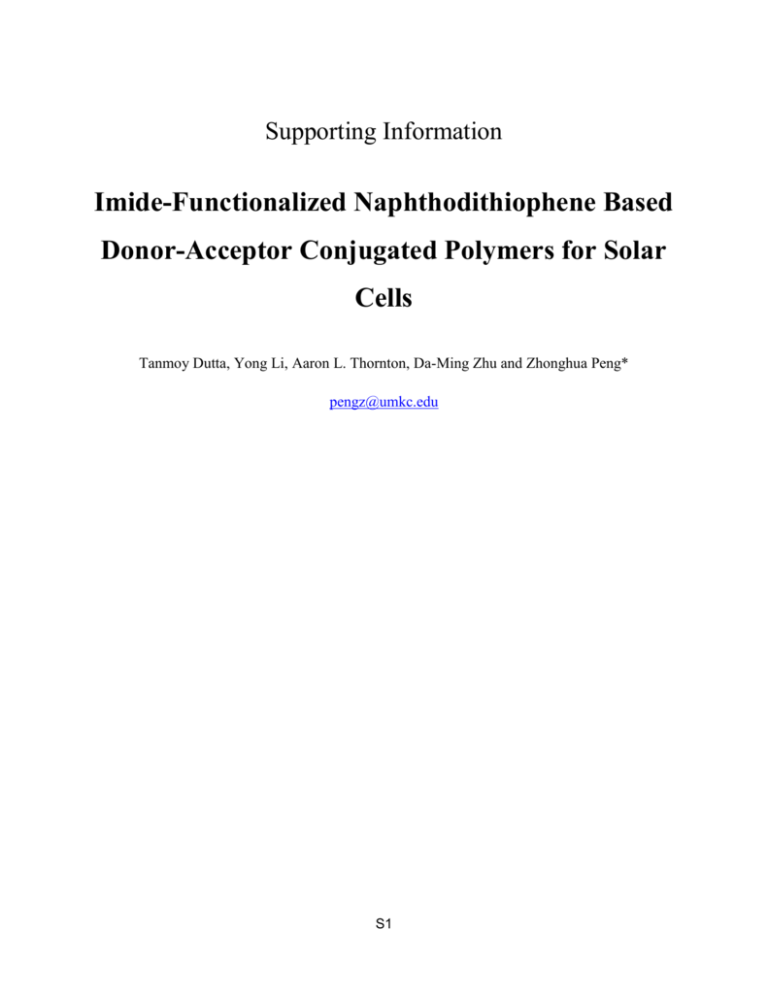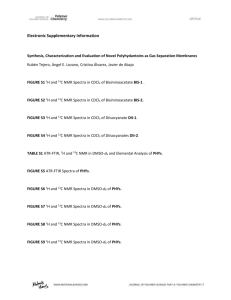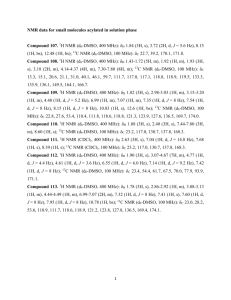pola26799-sup-0001-suppinfo
advertisement

Supporting Information Imide-Functionalized Naphthodithiophene Based Donor-Acceptor Conjugated Polymers for Solar Cells Tanmoy Dutta, Yong Li, Aaron L. Thornton, Da-Ming Zhu and Zhonghua Peng* pengz@umkc.edu S1 Table of contents Page 1. 1H and 13C NMR spectra of compounds 2–6……....…...…………………..…..…………S3-13 2. 1H NMR spectra of polymers.……………...……....………………….…………………S14-16 3. Optical properties of PDR.….……………...……....…………………………..……………S17 4. Optical properties of PBOR.….……………...……....……………………..……………….S18 5. Optical properties of PBH.….……………...……....…………………….…………….……S19 6. Picture of dilute solutions of polymers……...……....…………………………….…………S20 S2 ~~ ** ~~ * ~ * Figure S1: 1H (top) and 13C (bottom) NMR (CDCl3, 298K) spectra of 2a (*solvent). S3 * ~~ * Figure S2: 1H (top) and 13C (bottom) NMR (CDCl3, 298K) spectra of 2b (*solvent). S4 * ~ * Figure S3: 1H (top) and 13C (bottom) NMR (CDCl3, 298K) spectra of 3a (*solvent). S5 * ~~ * Figure S4: 1H (top) and 13C (bottom) NMR (CDCl3, 298K) spectra of 3b (*solvent). S6 * ~~ * Figure S5: 1H (top) and 13C (bottom) NMR (CDCl3, 298K) spectra of 4a (*solvent). S7 * ~~ * Figure S6: 1H (top) and 13C (bottom) NMR (CDCl3, 298K) spectra of 4b (*solvent). S8 ~~ * Figure S7: 1H (top) and 13C (bottom) NMR (CDCl3, 298K) spectra of 5a (*solvent). S9 * ~~ * Figure S8: 1H (top) and 13C (bottom) NMR (CDCl3, 298K) spectra of 5b (*solvent). S10 * Figure S9: 1H NMR (CDCl3, 298K) spectra of 6a (*solvent). S11 * Figure S10: 1H NMR (CDCl3, 298K) spectra of 6b (*solvent). S12 * Figure S11: 1H NMR (CDCl3, 298K) spectra of 6c (*solvent). S13 ~~ * ~~ * Figure S12: 1H NMR(C2D2Cl4) of PBOR, top: spectra at 298K; bottom: spectra at 348K (*solvent). S14 ~~ * ~~ * Figure S13: 1H NMR(C2D2Cl4) of PBH , top: spectra at 298K; bottom: spectra at 348K (*solvent). S15 ~~ * ~~ * Figure S14: 1H NMR(C2D2Cl4) of PDR, top: spectra at 298K; bottom: spectra at 348K (*solvent). S16 a Intensity (au) Intensity (au) b 200 300 400 500 Wavelength (nm) 600 400 500 600 Wavelength (nm) 700 Figure S15: (a) Excitation spectra of PDR in THF, black: emission wavelength at 531 nm; red: emission wavelength at 600 nm. (b) Emission spectra of PDR in THF, black: exited at 404 nm; red: excited at 432 nm. S17 800 Figure S16: Dilution effects on the emission spectra of PBOR in THF (black: 10-5 M solution). S18 Figure S17: Dilution effect on the emission intensity ratio of peaks at 524, 558 and 595 nm of PBH (excited at 442 nm), black: 10-5 M solution in THF, red: 10-6 M solution in THF. Intensity (au) 200 b Normalized Intensity (au) a 300 400 500 W avelength (nm) 600 400 500 600 700 W avelength (nm) 800 Figure S18: (a) Excitation spectra of PBH in THF, black: emission wavelength at 524 nm; red: emission wavelength at 558 nm; green: excitation wavelength at 595 nm. (b) Emission spectra of PBH in THF, black: exited at 442 nm; red: excited at 530 nm. S19 Figure S19: 10-4 M solutions of the polymers. PDOR in chlorobenzene, other polymers in THF. S20

![Calix[4]pyrroles bearing quinolinium moiety for halide sensing in](http://s3.studylib.net/store/data/007156474_1-c82458aad35825f0b14311ab261358ea-300x300.png)
